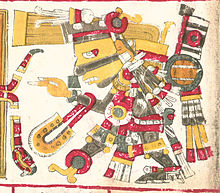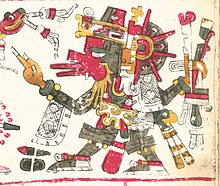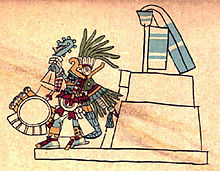Aztec creator gods
In
Each of the four sons takes a turn as Sun, these suns are the
The Tezcatlipocas created four couple-gods to control the waters by
List
| Cardinal direction | Names | Description | |
|---|---|---|---|
| North | Tezcatlipoca (Tezcatlipōca) | Smoking Mirror | God of providence, the invisible and darkness, lord of the Night and the Ursa Major. Ruler of the North |
| East | Xipe Totec (Xīpe Tōtec) | Our Lord The Flayed One | God of force and agriculture, lord of seasons, regeneration and crafts. Ruler of the East |
| West | Quetzalcoatl (Quetzalcohuātl) | Feathered Serpent | God of life, light and wisdom, lord of the day and the winds. Ruler of the West |
| South | Huitzilopochtli (Huītzilopōchtli)
|
Left-handed Hummingbird | God of war and will, lord of the Sun and fire. Ruler of the South |

- Camaxtle.
- Quetzalcoatl was also related to gods of the wind, of Venus, of the dawn, of merchants and of arts, crafts and knowledge. He was also the patron god of the Aztec priesthood, of learning and knowledge, patron of priests, the inventor of the calendar and of books, and the protector of goldsmiths and other craftsmen. As the morning and evening star, Quetzalcoatl was the symbol of death and resurrection. A feathered serpent deity has been worshipped by many different ethno-political groups in Mesoamerican history.
- Aztlan, their traditional home, to the Valley of Mexico.
Black Tezcatlipoca

Black Tezcatlipoca is Tezcatlipoca, and he was generally represented with a stripe of black paint across his face and an obsidian mirror in place of one of his feet. The post-Classic (after ad 900) Maya-Quiche people of
By Aztec times (14th–16th century ad), Tezcatlipoca's manifold attributes and functions had brought him to the summit of the divine hierarchy, where he ruled together with
Red Tezcatlipoca

Red Tezcatlipoca is Xipe-Totec or Camaxtle, and his representations first appeared at
White Tezcatlipoca

White Tezcatlipoca is Quetzalcoatl that one important body of myths describes
Blue Tezcatlipoca

Blue Tezcatlipoca is Huitzilopochtli, and his representations usually show him as a hummingbird or as a warrior with armour and helmet made of hummingbird feathers. In a pattern similar to that found in many hummingbirds, his legs, arms, and the lower part of his face were painted one color (blue) and the upper half of his face was another (black). He wore an elaborate feathered headdress and brandished a round shield and a turquoise snake. Huitzilopochtli is presented as the deity who guided the long migration the Aztecs undertook from
The legend of Huitzilopochtli is recorded in the
Bibliography
- Instituto de Investigaciones Históricas, ed. (1975). Códice Chimalpopoca. Anales de Cuauhtitlán y Leyenda de los Soles (in Spanish). México. p. 161. ISBN 968-36-2747-1.)
{{cite book}}: CS1 maint: location missing publisher (link - Panorama Editorial, ed. (1998). Dioses Prehispánicos de México (in Spanish). México. p. 162. ISBN 968-38-0306-7.)
{{cite book}}: CS1 maint: location missing publisher (link - Biblioteca Porrúa. Imprenta del Museo Nacional de Arqueología, Historia y Etnología, ed. (1905). Diccionario de Mitología Nahua (in Spanish). México. p. 851. ISBN 978-9684327955.)
{{cite book}}: CS1 maint: location missing publisher (link - Editorial Universo México, ed. (1981). El Mundo Mágico de los Dioses del Anáhuac (in Spanish). México. p. 153. ISBN 968-35-0093-5.)
{{cite book}}: CS1 maint: location missing publisher (link - Oxford University Press, ed. (2001). Dictionary of Ancient Deities. United States. p. 608. ISBN 978-0195145045.)
{{cite book}}: CS1 maint: location missing publisher (link - Library of Congress, ed. (2004). Dictionary of Gods and Goddesses. United States. p. 402. ISBN 0-8160-5923-3.)
{{cite book}}: CS1 maint: location missing publisher (link - Migne, ed. (1881). Dictionnaire universel, historique et comparatif, de toutes les religions du monde : comprenant le judaisme, le christianisme, le paganisme, le sabéisme, le magisme, le druidisme, le brahmanisme, le bouddhismé, le chamisme, l'islamisme, le fétichisme; Volumen 1,2,3,4 (in French). France. p. 602.
{{cite book}}: CS1 maint: location missing publisher (link)
References
- ISBN 968-35-0093-5.)
{{cite book}}: CS1 maint: location missing publisher (link - ISBN 970-07-3149-9.
- ^ ISBN 968-35-0093-5.
- ^ Huitzilopochtli Archived May 8, 2012, at the Wayback Machine

